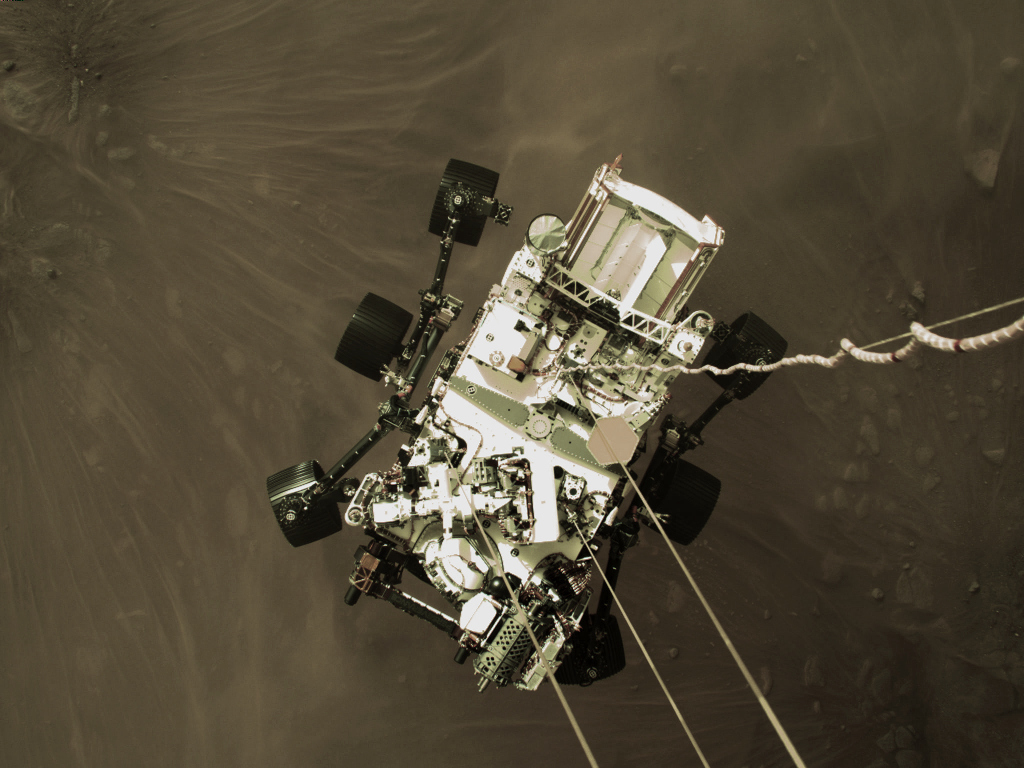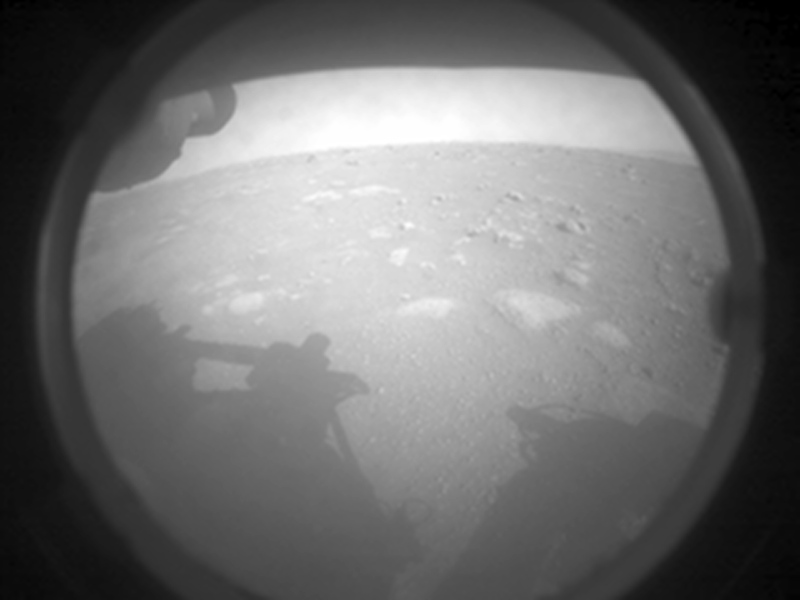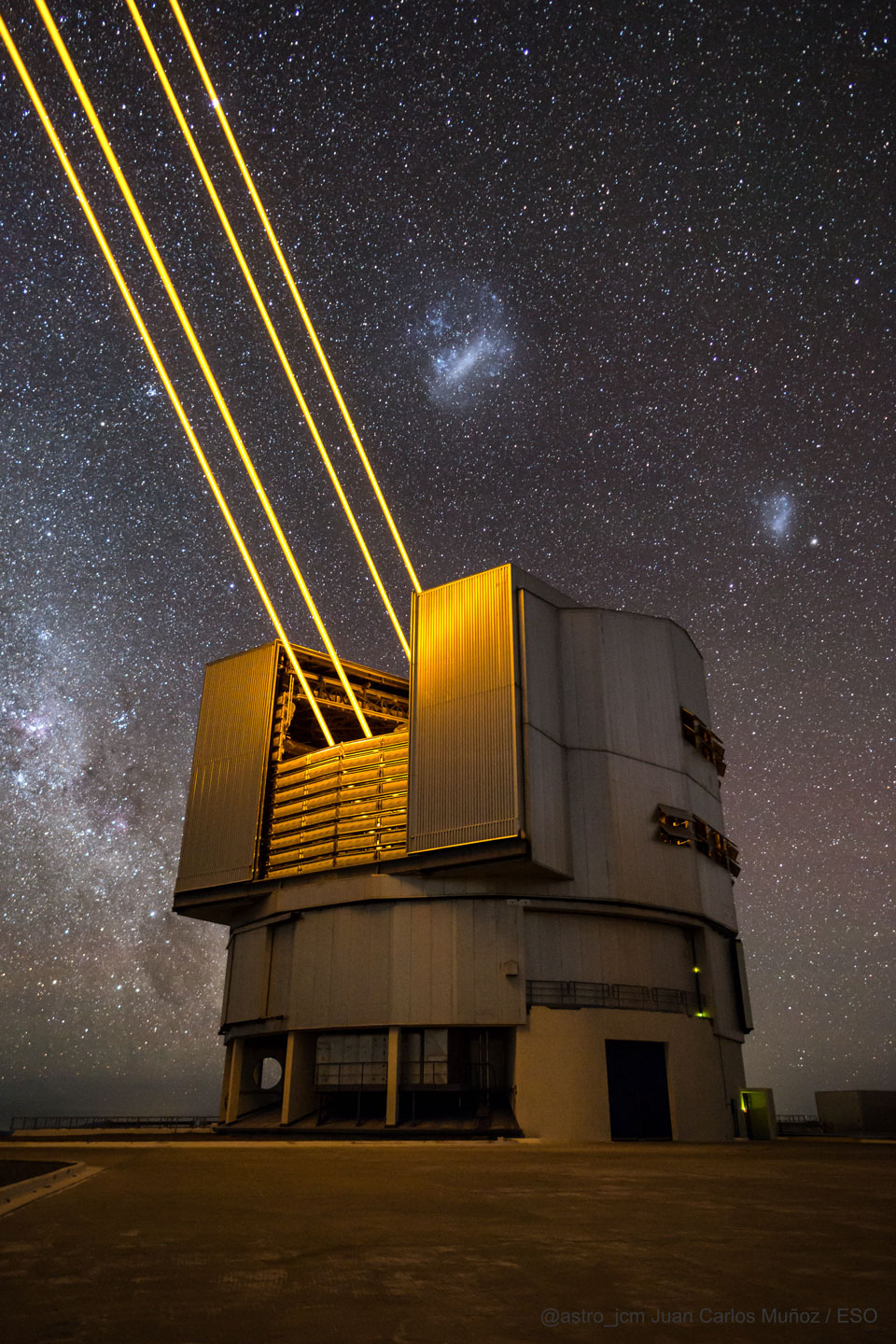Nombre total de pages vues
20/02/2021
ASTRONOMY - NASA’s SDO Captures Brilliant Solar Eruption T
ASTRONOMY - Perseverance: How to Land on Mars
2021 February 20
Image Credit: NASA, JPL, Mars 2020
Explanation: Slung beneath its rocket powered descent stage Perseverance hangs only a few meters above the martian surface, captured here moments before its February 18 touchdown on the Red Planet. The breath-taking view followed an intense seven minute trip from the top of the martian atmosphere. Part of a high resolution video, the picture was taken from the descent stage itself during the final skycrane landing maneuver. Three taut mechanical cables about 7 meters long are visible lowering Perseverance, along with an electrical umbilical connection feeding signals (like this image), to a computer on board the car-sized rover. Below Perseverance streamers of martian dust are kicked-up from the surface by the descent rocket engines. Immediately after touchdown, the cables were released allowing the descent stage to fly to a safe distance before exhausting its fuel as planned.
19/02/2021
ASTRONOMY -- Mars Perseverance Sol 0
2021 February 19
Image Credit: NASA, JPL, Mars 2020
Explanation: After a 203 day interplanetary voyage, and seven minutes of terror, Perseverance has landed on Mars. Confirmation of the successful landing at Jezero crater was announced from mission control at NASA’s Jet Propulsion Laboratory in Southern California at 12:55 pm PST on February 18. The car-sized Mars rover's Front Left Hazard Avoidance Camera acquired this initial low resolution image shortly after touchdown on mission Sol 0. A protective cover is still on the camera, but the shadow of Perseverance, now the most ambitious rover sent to the Red Planet, is visible cast across the martian surface.
18/02/2021
ASTRONOMIE - Naissance de l'astronomie moderne (1)
Nous sommes au début du XIXe siècle. La théorie de l’héliocentrisme qui défend que la Terre et les planètes sont en orbite autour du Soleil est acceptée. Mais depuis presque deux siècles, les découvertes scientifiques dans le domaine de l’astronomie se font au compte-gouttes.
Parmi les quelques faits remarquables tout de même, en 1755 le philosophe Emmanuel Kant tente pour la première fois d’expliquer la formation du Système solaire en utilisant la mécanique, et notamment les travaux de Newton. En 1769, l’explorateur James Cook effectue une mesure directe inédite : celle des distances Terre-Vénus-Soleil. Uranus est enfin considérée comme une planète grâce à l’astronome britannique Nevil Maskelyne, et William Herschel découvre en 1787 ses deux premiers satellites Titania et Obéron.
ASTRONOMY - Swiss Alps, Martian Sky
2021 February 18
Image Credit & Copyright: Jens Bydal
Explanation: Taken on February 6, this snowy mountain and skyscape was captured near Melchsee-Frutt, central Switzerland, planet Earth. The reddish daylight and blue tinted glow around the afternoon Sun are colors of the Martian sky, though. Of course both worlds have the same Sun. From Mars, the Sun looks only about half as bright and 2/3 the size compared to its appearance from Earth. Lofted from the surface of Mars, fine dust particles suspended in the thin Martian atmosphere are rich in the iron oxides that make the Red Planet red. They tend to absorb blue sunlight giving a red tinge to the Martian sky, while forward scattering still makes the light appear relatively bluish near the smaller, fainter Martian Sun. Normally Earth's denser atmosphere strongly scatters blue light, making the terrestrial sky blue. But on February 6 a huge cloud of dust blown across the Mediterranean from the Sahara desert reached the Swiss Alps, dimming the Sun and lending that Alpine afternoon the colors of the Martian sky. By the next day, only the snow was left covered with reddish dust.
17/02/2021
ASTRONOMY - Sun Pillar with Upper Tangent Arc
2021 February 17
Image Credit & Copyright: Mike Cohea
Explanation: This was not a typical sun pillar. Just after sunrise two weeks ago in Providence, Rhode Island, USA, a photographer, looking out his window, was suddenly awestruck. The astonishment was caused by a sun pillar that fanned out at the top. Sun pillars, singular columns of light going up from the Sun, are themselves rare to see, and are known to be caused by sunlight reflecting from wobbling, hexagon-shaped ice-disks falling through Earth's atmosphere. Separately, upper tangent arcs are known to be caused by sunlight refracting through falling hexagon-shaped ice-tubes. Finding a sun pillar connected to an upper tangent arc is extraordinary, and, initially, took some analysis to figure out what was going on. A leading theory is that this sun pillar was also created, in a complex and unusual way, by falling ice tubes. Few might believe that such a rare phenomenon was seen again if it wasn't for the quick thinking of the photographer -- and the camera on his nearby smartphone.
15/02/2021
ASTRONOMY - Landing on Mars: Seven Minutes of Terror
2021 February 15
Video Credit: NASA, JPL
Explanation: Starting Thursday, there may be an amazing new robotic explorer on Mars. Or there may be a new pile of junk. It all likely depends on things going correctly in the minutes after the Mars 2020 mission arrives at its new home planet and attempts to deploy the Perseverance rover. Arguably the most sophisticated landing yet attempted on the red planet, consecutive precision events will involve a heat shield, a parachute, several rocket maneuvers, and the automatic operation of an unusual device called a Sky Crane. Thursday's Seven Minutes of Terror echo the landing of the Curiosity rover on Mars in 2012, as depicted in the featured video. If successful, the car-sized Perseverance rover will rest on the surface of Mars, soon to begin exploring Jezero Crater to better determine the habitability of this seemingly barren world to life -- past, present, and future. Although multiple media outlets may cover this event, one way to watch these landing events unfold is on the NASA channel live on the web.
10/02/2021
ASTRONOMY - Firing Lasers to Tame the Sky
2021 February 10
Image Credit & Copyright: Juan Carlos Muñoz / ESO; Text: Juan Carlos Muñoz
Explanation: Why do stars twinkle? Our atmosphere is to blame as pockets of slightly off-temperature air, in constant motion, distort the light paths from distant astronomical objects. Atmospheric turbulence is a problem for astronomers because it blurs the images of the sources they want to study. The telescope featured in this image, located at ESO’s Paranal Observatory, is equipped with four lasers to combat this turbulence. The lasers are tuned to a color that excites atoms floating high in Earth's atmosphere -- sodium left by passing meteors. These glowing sodium spots act as artificial stars whose twinkling is immediately recorded and passed to a flexible mirror that deforms hundreds of times per second, counteracting atmospheric turbulence and resulting in crisper images. The de-twinkling of stars is a developing field of technology and allows, in some cases, Hubble-class images to be taken from the ground. This technique has also led to spin-off applications in human vision science, where it is used to obtain very sharp images of the retina.
09/02/2021
ASTRONOMY - Flashes of the Crab Pulsar
2021 February 9
Video Credit & Copyright: Martin Fiedler
Explanation: It somehow survived an explosion that would surely have destroyed our Sun. Now it is spins 30 times a second and is famous for the its rapid flashes. It is the Crab Pulsar, the rotating neutron star remnant of the supernova that created the Crab Nebula. A careful eye can spot the pulsar flashes in the featured time-lapse video, just above the image center. The video was created by adding together images taken only when the pulsar was flashing, as well as co-added images from other relative times. The Crab Pulsar flashes may have been first noted by an unknown woman attending a public observing night at the University of Chicago in 1957 -- but who was not believed. The progenitor supernova explosion was seen by many in the year 1054 AD. The expanding Crab Nebula remains a picturesque expanding gas cloud that glows across the electromagnetic spectrum. The pulsar is now thought to have survived the supernova explosion because it is composed of extremely-dense quantum-degenerate matter.
ASTRONOMY - Diamond Dust Sky Eye
2024 December 25 Diamond Dust Sky Eye Image Credit & Copyright: Jaroslav Fous Explanation: Why is there a huge eye in the sky? Diamon...

-
2021 May 11 Lightning and Orion Beyond Uluru Image Credit & Copyright: Park Liu Explanation: What's happening behind Uluru? A Un...
-
Extraordinary Solar Halos Image Credit & Copyright : Magnus Edback Explanation: Welcome to the December Solstice, the first...







